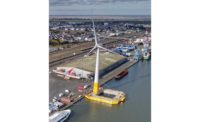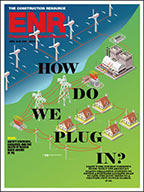Prospects for carbon-free power is getting a double boost in Europe. France is about to procure an estimated $14-billion of offshore wind farms. And the U.K. is setting itself tough greenhouse gas targets, increasing its reliance on renewable and nuclear energy.

Three of France’s biggest engineering companies have formed an alliance to bid this month or next for a slice of 3,000-MW of offshore wind power the government plans to have in operation by 2015. Another 3,000-MW is due to follow five years later.
The Paris-based companies Vinci Group, GDF SUEZ S.A and Areva S.A. will jointly to bid for development rights for three of the five initial farms. The north coast installations, at Dieppe-Le Tréport, Courseulles-sur-Mer and Fécamp will have a combined capacity of 1,750-MW.
In a parallel development, the U.K.’s Energy Technologies Institute, Loughborough, on May 18 invited firms to apply for a slice of the $16-million project to develop super-long wind turbine blades for the next generation of 8-10 MW offshore machines. At over 90-m long, the blades will 50% longer than those now in operation.
With government backing, the turbine project is part of U.K. push to decarbonise energy production. This month, the government agreed a new national emissions reduction target of a 50% below 1990 levels by 2027. “By cutting emissions we’re also getting ourselves off the oil hook,” said Chris Huhne, Secretary of State of energy and climate change.
The U.K. Committee on Climate Change, which recommended the target, forecasts the contribution of renewables to national energy production rising from 3% now to 30-45% by 2030. The committee calls for a portfolio approach to overcome technological uncertainties .
Carbon capture and storage remains “promising but highly uncertain”, notes the committee. Offshore wind is “significantly more expensive” than nuclear or onshore wind, which is “close to competitive”. Wave and tidal power “may be promising, given significant resource potential and scope for cost reduction”, it notes.
Prospects for marine renewables face “considerable uncertainties” adds the not-for-profit Carbon Trust Ltd., London, in a new analysis. Nevertheless, it forecasts deployment possibly ramping up during the next decade, rising to as much as 240,000-MW by 2050 globally.
Nuclear power appears to be “the most cost-effective” low carbon option, notes the climate change committee. But doubts remain over costs, site availability, long-term fuel supply, waste disposal and public acceptability, it adds.
The biggest recent doubt over the U.K.’s plans for new nuclear was partially dispelled on May 18 by interim findings of a safety investigation into implications of the Japanese disaster at Fukushima.
Mike Weightman, executive head of the Office for Nuclear Regulation broadly concluded that the U.K. is not exposed to the natural hazards that contributed to the Japanese accident. Also, U.K. plants are of different, safer type.
“I see no reason why we should not proceed with our current (nuclear) policy,” reported Huhne, following Weightman’s findings. “We want to see new nuclear as part of a low carbon energy mix,” he added.




